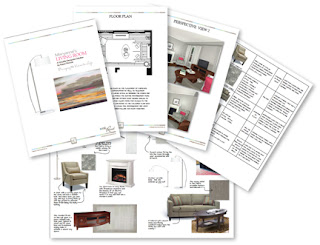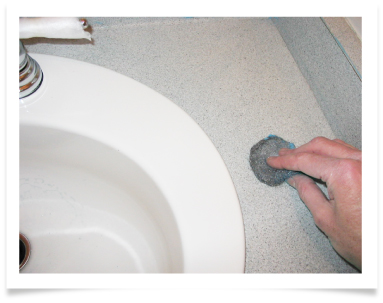My Faux Granite Counter Makeover
My downstairs powder room was in desperate need of a makeover and, as usual, I needed a simple and inexpensive way to make it look great! Later I will do a post on all that was done, but for now, I'm going to focus on the countertop. It was a boring grey laminate, but a simple DIY project has transformed it into a sleek, glossy chocolate granite! You'll have to excuse the excessive amount of photos, but, for this project, I think they're warranted.
I used the
Giani Granite Paint for Countertops in Chocolate Brown. The kit costs around $80 and you can get it at Wal-Mart or a local paint and decor store. The kit comes complete with everything you need, with the exception of a small roller tray, fine grit sandpaper, a small artist's brush and painter's tape. You also get a sheet of heavy, black construction paper to practice on, so definitely make use of it!
And, the process is so simple, as long as you can hold a sponge and a brush in your hand, you're good to go!
This was my countertop before. It's pretty clear why it needed a bit of a 'WOW' factor.
The first step is to clean your counter well so the primer will adhere properly.
I used a steel wool scouring pad--you know the one :)
RINSE WELL! I rinse with a sponge about 3 times to make sure all the cleanser residue was removed.
**Also make sure you remove all the caulking from around the sink and counter top edges**
Carefully mask off the entire area.
There is no such thing as overkill here, trust me!
Roll on the black primer
Here are the 3 colours that came with the Chocolate Brown Kit
You're supposed to start with the medium toned colour fist, but I started with the lightest. Here's my first layer. I attempted to try some veining, but you'll notice that I sponged over them throughout the process--I just wasn't happy with them.
After the second colour was applied
After the third colour was applied
It was a little lighter than I wanted, so I added more of the dark brown
It looked really good, but I was after a softer look, so I just kept dabbing and blending the colours until I was happy with the result
The last step is to apply the topcoat. I wanted a smooth finish, so I lightly sanded with 400 grit sandpaper before I put on the topcoat. You're supposed to use 600 grit but the 400 seemed to work well too. If you decide to do this, make sure the you remove ALL sanding dust before applying the topcoat. To ensure the smoothest finish possible, I applied 3 coats of topcoat and sanded between each coat.
*Please ignore the handles--they WILL be changed!
I found it hard to get long even rolls during the topcoat process, so I would remove the sink if possible.Close up (still need to caulk around the sink)
I'm quite happy with the results and am already trying to think of what else I can 'Granite-ize'!
































